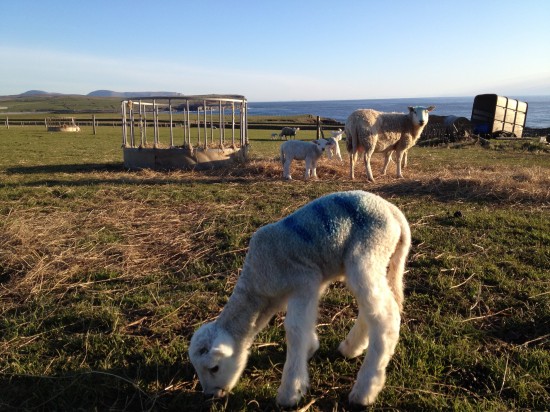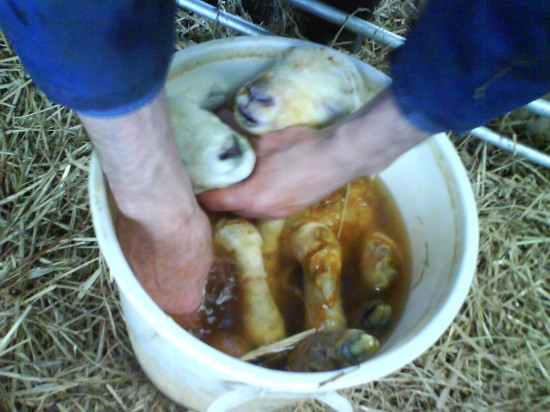A few months back, we opened an email from Amy Liptrot. She told us a bit about her life, now lived just beyond the edge of the mainland. She’d left London to return home to Orkney, where she’s trying to get the big city out of her system. We wanted to know more. Here, she writes about the highs and lows of lambing season.
Last week Dad went to check on a ewe he’d left to give birth an hour or so before, due to have triplets. He was surprised to only see one lamb with her then realised the other two were under her body – she’d crushed her two larger lambs to death, leaving only the runt. That day the tiny lamb began shitting blood and it became apparent that she’d stood on it as well, damaging his insides in an unknown but terrible way which soon proved fatal. The sheep – ‘killer mum’ – was identified as a bad mother and given the ‘black dot’ meaning she will not be kept until next year.
Lambing season is the best time of year on the farm but is by turns delightful and grotesque, sweet and sour. Twice in the last few years, when jobs or relationships in London had gone wrong, I’ve come up and worked as my Dad’s lambing assistant for the season, hoping that being held on the island, and within that the farm, would keep me sober for a while.

I do the early morning shift but the sheep are already awake by the time I arrive to the shed. Dad will have been up in the night and leaves notes for me at four or five AM detailing the latest lambs and things to watch out for. We have around 220 ewes, scanned to carry an average of 1.8 lambs each. Most will give birth to their lambs unassisted but the occasional ewe will need help: to pull out a large single with its head stuck or to untangle the limbs of twins or triplets – a job I would sometimes be called on to help with as a child because my hands were smaller than Dad’s.
Every hour I do my rounds of the shed and the field, my eyes dart to their back ends, keen that I will not miss any signs of lambing, looking out for sheep who are pointing in a different direction from the flock, lying on their own, or walking in circles crying out with confusion. Ewes in birth throes arch their backs downwards like plucked strings, muzzles pointed to the sky.
I remember lambing when I was a kid as being hectic and disorganised, with sheep getting loose and gory tragedy, but over the years, Dad has streamlined the system and bred good behaviour into the flock. They come when called, slow and heavy with lambs, following each other into the big shed for the night.
Across the field I spot a newborn lamb and as I get closer realise it must be dead, lying limp and still. The birth sack is still across its body and head, so with my fingers I puncture it at the mouth and peel it off like a condom. The lamb immediately sneezes, shakes itself and breathes deeply before letting out a healthy baa. The mother, who had given up and wandered away, is alerted by the sound and trots back to begin licking its newborn. In just a few minutes it will be walking and sucking, and tomorrow skipping around the field.

Lambs in a bucket – the fostering process
Managing the lambing makes me part caring midwife, part stern eugenicist. Because sheep only have two teats, ewes who have triplets must have one ‘fostered’ – as we call it, but really it’s more of a forced adoption. I feel like a 1950s doctor as I line up the three lambs to choose the largest to take away. We have waited until a ewe scanned to have a single has begun to give birth and as soon as her lamb is born, it it dunked into a bucket of warm water along with its new foster-sibling and they are stirred up together in a bloody brew with the afterbirth and fluids so that they get the same smell before being presented to the post-natal mother as if to say ‘yes dear, you did have two.’ Occasionally the imposter is detected and rejected but in the majority of cases the deception is a success.
In between the lambs, there are other jobs – building up a broken dyke, cutting down rogue thistles. At the end of the day I attend to my body, thinking about how it will function rather than how it looks: getting rid of any hangnails which could get caught, letting the hot shower massage my muscles.
Most lambs are healthy and we simply spray their navels with iodine to prevent infection and carry them by the front legs – mothers following – out onto the grass, but each year a handful have birth defects – there was a prolapsing umbilical chord last week – meaning they will not survive. On fine spring days the landscape glows, lambs play under calling curlews and oystercatchers, the sounds of the sea and the odd tractor far away, but when it rains the yard get muddier, the grass barer, the sheep huddle behind the dykes and I can’t hear much but the wind through my wooly hat.
These lambs born in April will either be sold in autumn as ‘store’ for another farmer to feed up, or over winter as ‘fat’, shipped to abattoirs south. If you buy ‘Scottish Organic Lamb’ in Tesco, it could have come from our farm.